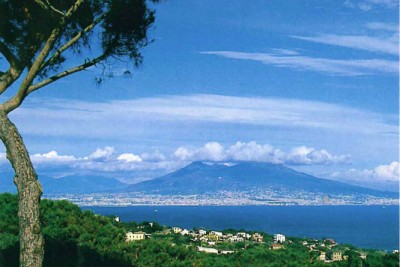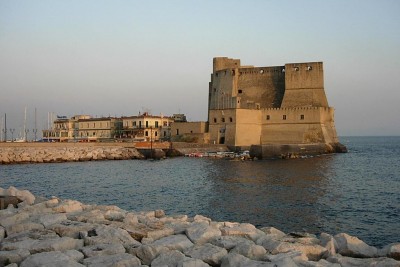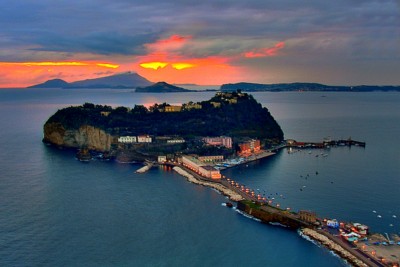The Royal Palace of the Bourbon Kings
This monumental mid-18th century Royal complex was designed by architect Luigi Vanvitelli to rival Versailles



The Reggia di Caserta was the residence of the Bourbon kings of Naples. In 1997, the palace was designated a UNESCO World Heritage Site, as "the swan song of the spectacular art of the Baroque, from which it adopted all the features needed to create the illusions of multidirectional space".
In terms of volume, it is the largest royal residence in the world. In 1734 Charles III, son of Philip V, became King of Naples, a self-governing kingdom that was no longer part of the Spanish realm.
In 1750 he decided to build a new royal palace, to rival Versailles. It was designed to be the center of a new town that would compete with other leading European cities. He employed architect Luigi Vanvitelli, then engaged in the restoration of St Peter's in Rome. Vanvitelli started construction in 1752, with inspiration from the Royal Palace of Madrid, designed by Filippo Juvarra for Charles' father, Philip V of Spain, and the Palais de Versailles. In the end, Charles III never slept a night at the Reggia, as he abdicated in 1759 to become King of Spain.
In 1773, his third son and successor, Ferdinand IV of Naples, decided to include also the Bosco di San Silvestro, a hunting park with vineyards and orchards. In that same year, 1773, Luigi Vanvitelli died. His son Carlo inherited the project, but wasn’t able to complete his father's original project, which included a vast pair of frontal wings similar to Bernini's wings at St. Peter's.

The monumental avenue that was planned to run 20 kilometers between the palace and Naples wasn’t ever built either. In April 1945 the palace was the site of the signing of the unconditional surrender of German forces in Italy.
The agreement covered between 600,000 and 900,000 soldiers along the Italian Front. The first Allied war crimes trial took place in the palace in 1945; German general Anton Dostler was sentenced to death and executed nearby, in Aversa.
The political and social model for Vanvitelli's palace was Versailles, which solved similar problems of assembling and providing for king, court and government in a massive building with the social structure of a small city, according to the Baroque view of a highly subordinated nature, or nature forcée.
One of the king's primary objectives was to have a new royal court and administrative center in a location protected from sea attack and distant from the revolt-prone and congested city of Naples.
The palace has some 1,200 rooms, including two dozens state apartments, a large library, and a theater modeled after the Teatro San Carlo of Naples.The four sides of the rectangular plan are connected by two orthogonal arms, forming four inner courts, each measuring more than 3,800 m2 (40,903 sq ft).
Of all the royal residences inspired by the Palace of Versailles, the Reggia di Caserta is the one that bears the greatest resemblance to the original model: the unbroken balustraded skyline and the slight break provided by pavilions within the long, somewhat monotonous façade.
The structure is crowned by a central cupola. In front of the main façade is the elliptical parade ground.
Inside, there are three octagonal vestibules, aligned on the main axis of the building and acting as fulcrums for the entire complex.

The monumental main staircase gives access to the royal apartments, which are decorated and furnished in 18th-century style. The royal palace has more than 40 monumental rooms completely decorated with frescoes. By comparison, Versailles counts only 22 monumental rooms with frescoes.
The rooms offer a continuous succession of stuccoes, reliefs, frescoes, sculptures, and inlays. The embellishments that stand out the most are located in the Sala di Astrea, Sala di Marte and Sala del Trono. This last sala, the largest of the interior royal apartments, was used for the reception and accommodation of important personalities of the day.
The most striking setting in the Palace is probably where the atrium, the grand Royal Staircase and the chapel meet. The Royal Staircase is a classic 17th century scenographic feature; it connects the lower and upper vestibules, giving access to the royal apartments via the upper.
More than any other environment here, the Palatine Chapel, also designed by Vanvitelli, exhibits the strongest similarities to Versailles, with all of its decorations.
The Pinacoteca’s (Painting Gallery's) interior is organized as a series of connected room that display countless works of still lives, war scenes, and portraits of the members of the Bourbon Dynasty.
In the "old apartment" the Nativity is always on show. The Nativity Scene was a great passion of the noble Bourbon family, and it is thanks to them that the Nativity tradition spread from Naples to the rest of the world.
The Palatine Library, executed according to Vanvitelli’s design, is annexed to the Queen’s Apartments and is decorated by reliefs and frescoes that depict the zodiac signs and the constellations. Also evocative are the rooms dedicated to the four seasons.
The Apartment of the King includes the Sala del Consiglio, the drawing room of Francis II, which houses a console table with a top made from semi-precious stones worked by Neapolitan craftsmen, the bedroom and the bathroom.
The Murat Apartment has Empire-style furnishings from the old Royal Palace of Portici, the favorite residence of Gioacchino Murat and Carolina Bonaparte.
The Old Apartment, or 18th century Apartment, with the two rooms used by Ferdinand IV of Bourbon, is dominated by the colors white and gold, and has fabrics from the silk mills of San Leucio.
On the west side of the Reggia is the Teatro di Corte, an example of 18th century theater architecture of rare beauty.

Also inspired by Versailles is the park, a typical example of the Baroque extension of formal vistas, that stretches for over 200 acres, partly on hilly terrain. It starts from the back façade of the palace, flanking a long alley with artificial fountains and cascades.
The main axis is punctuated by a series of Baroque fountains and stretches of water. The magnificent perspective terminates in the Great Fountain, where water cascades down from a height of 150 mt into an ornate basin that depicts Diana bathing, observed by Actaeon (sculptures by Paolo Persico, Brunelli and Pietro Solari).
The fountains and cascades, each filling a vasca ("basin"), with architecture and hydraulics by Luigi Vanvitelli at intervals along a wide straight canal that runs to the horizon, rivaled those at Peterhof outside St. Petersburg, and include the Fountain of Venus and Adonis (1770–800), the Fountain of the Dolphins (1773–80), the Fountain of Aeolus, and the Fountain of Ceres.
A large number of figures from classical antiquity were modeled by Gaetano Salomone for the gardens of the Reggia, and executed by large workshops. There is also a botanical garden, called "The English Garden", in the upper part designed in the 1780s by Carlo Vanvitelli and the German-born botanist and garden-designer John Graefer.
Reggia di Caserta
Via Douhet, 22 Caserta
Open every day except Tuesday from 8.30 AM to 7.30 PM (last admission 30 minutes before closing time)
In January, February, November, December the park closes 2.30 PM.
In March at 4.00 PM In April at 5.00 PM.
In June, July and August at 6.00 PM.
In October at 4.30 PM.The English Garden closes one hour before the park closes.
Tel: (+39) 0823 448084
Tickets for the apartments: € 9.00
EU citizens between 18 and 25: € 4.50
With the ArteCard: € 4.50
EU citizens under 18 and over 65: free
Apartment and park: € 12.00
EU citizens between 18 and 25: € 6.00
With the ArteCard: € 6.00
EU citizens under 18 and over 65: free
WE SUGGEST THESE VIDEOS ON THE REGGIA DI CASERTA



